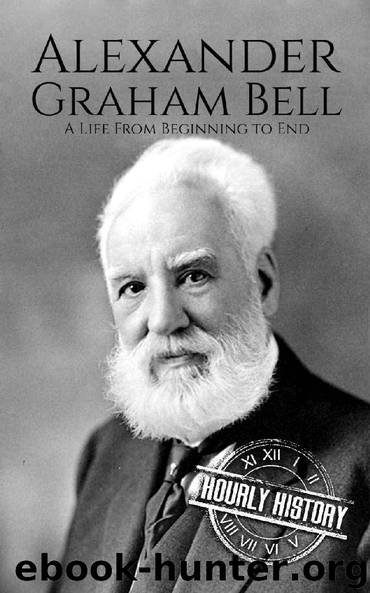Alexander Graham Bell: A Life From Beginning to End (Biographies of Innovators Book 2) by Hourly History

Author:Hourly History [History, Hourly]
Language: eng
Format: epub
Publisher: Hourly History
Published: 2018-01-09T06:00:00+00:00
Chapter Seven
The Photophone & The National Geographic
“I have been able to hear a shadow and I have even perceived by ear the passage of a cloud across the sun’s disk. I have heard articulate speech produced by sunlight!”
—Alexander Graham Bell in a letter to his father on the subject of the photophone.
By the 1880s the Bells were living comfortably thanks to their selling of Bell Telephone shares at the right time. They relocated to Washington D.C. in 1879. Bell now had little to do with the telephone company other than appearing as a witness in a series of patent trials which were brought against them. At 32, Bell had reached a point in his life which most men never achieve. He had perfected a breakthrough invention that was revolutionizing society. He had founded a great company which was growing into a corporate colossus and had made his fortune. To achieve so much at such a young age is a remarkable achievement, made even more remarkable when considering that for the most of the time he was working part-time as an inventor and full time as a teacher.
Now Bell’s mind turned to a further enhancement of his invention. He had proved it was possible to transmit a voice electronically over a wire. Could it be done wirelessly—perhaps using light as its medium? His inspiration was the work of an Atlantic telegraph engineer named Willoughby Smith who had used the element selenium for the cable due to its high resistance. He reported that the resistance seemed to vary depending on whether it was day or night. To Bell this seemed to suggest that it would be possible to hear the moment when sunlight fell across the wire. To this end he began to experiment, aided by Charles Sumner Tainter, a maker of optical instruments. They constructed an apparatus that used mirrors to reflect sunlight into the machine and a lens to focus it. A rubber mouthpiece directed the sound of the voice onto a transmitter.
Their idea was that sound waves striking a mirror on one side would affect the light waves being reflected from the other side. A dish collected the reflected light and directed into onto a cell of selenium which was connected to a circuit with a telephone. They began experimenting with different wavelengths of light and with polarized light as well as sunlight to see which had the biggest effect. Bell stockpiled selenium, a rare element, until he believed he had the world’s largest single supply. The selenium used was prepared as a delicate crystal with very low resistance, making it sensitive to the smallest degree of light.
On February 22, 1880, he tested the machine, which he named the photophone, with his cousin, Charles. Charles Bell operated the transmitting photophone in one room while Bell listened in the basement. In his notes, Bell described hearing the words “hoy, hoy, hoy” with the vowels particularly distinct. He also made out the words to “God Save the Queen” and sentences “Do
Download
This site does not store any files on its server. We only index and link to content provided by other sites. Please contact the content providers to delete copyright contents if any and email us, we'll remove relevant links or contents immediately.
LORD OF THE FLIES by William Golding(1812)
Her Majesty's Spymaster by Stephen Budiansky(1056)
Lord Of The Flies by Golding William(1044)
In the Garden of Beasts by Erik Larson(1031)
Homage to Catalonia by George Orwell(996)
The Lady Penelope by Varlow Sally(994)
Children Of England: The Heirs of King Henry VIII 1547-1558 by Weir Alison(955)
Fall of the Roman Republic (Penguin Classics) by Plutarch(942)
Atomic Spy by Nancy Thorndike Greenspan(936)
Remember Us by Martin Small(899)
Mussolini's Italy by R. J. B. Bosworth(831)
The Last President of Europe by William Drozdiak(817)
Gimson's Kings and Queens by Andrew Gimson(811)
London: A Biography by Peter Ackroyd(803)
Rome in Crisis (Penguin Classics) by Plutarch(797)
Catastrophe 1914: Europe Goes to War by Max Hastings(758)
The Twelve Caesars (Penguin Classics) by Suetonius & Robert Graves(753)
In the Garden of Beasts: Love, Terror, and an American Family in Hitler's Berlin by Erik Larson(752)
The Cousins' War - 01 - The White Queen by Philippa Gregory(743)
